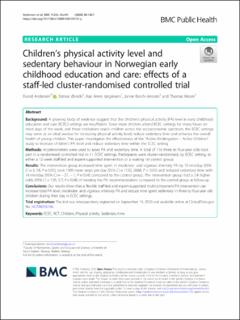| dc.contributor.author | Andersen, Eivind | |
| dc.contributor.author | Øvreås, Steinar | |
| dc.contributor.author | Jørgensen-Vittersø, Kari Anne | |
| dc.contributor.author | Borch-Jenssen, Janne | |
| dc.contributor.author | Moser, Thomas | |
| dc.date.accessioned | 2021-04-08T09:28:26Z | |
| dc.date.available | 2021-04-08T09:28:26Z | |
| dc.date.created | 2021-01-18T08:22:28Z | |
| dc.date.issued | 2020 | |
| dc.identifier.citation | Andersen, E., Øvreås, S., Jørgensen, K. A., Borch-Jenssen, J. & Moser, T. (2020). Children’s physical activity level and sedentary behaviour in Norwegian early childhood education and care: effects of a staff-led cluster-randomised controlled trial. BMC Public Health, 20, 1651. | en_US |
| dc.identifier.issn | 1471-2458 | |
| dc.identifier.uri | https://hdl.handle.net/11250/2736814 | |
| dc.description | The Editors of the journal have retracted this article. After publication, concerns were raised about the statistical significance of the findings. Post-publication review found additional issues such as excluding individuals with missing observations, testing repeating physical activity (Fig. 3) instead of repeated measure analysis, and lack of clarity about how the accelerometer data was summarised and assessed as the results were not easily reproducible. Therefore, the Editors have lost confidence in the findings of this study. The authors did not state explicitly whether they agree to this retraction. | |
| dc.description.abstract | Background: A growing body of evidence suggest that the children’s physical activity (PA) level in early childhood education and care (ECEC) settings are insufficient. Since most children attend ECEC settings for many hours on most days of the week, and these institutions reach children across the socioeconomic spectrum, the ECEC settings may serve as an ideal avenue for increasing physical activity level, reduce sedentary time and enhance the overall health of young children. This paper investigates the effectiveness of the “Active Kindergarten – Active Children” study to increase children’s PA level and reduce sedentary time within the ECEC setting.
Methods: Accelerometers were used to asses PA and sedentary time. A total of 116 three to four-year olds took part in a randomised controlled trial in 11 ECEC settings. Participants were cluster-randomised, by ECEC setting, to either a 12 week staff-led and expert-supported intervention or a waiting list control group.
Results: The intervention group increased time spent in moderate- and vigorous intensity PA by 10 min/day (95% CI = 3, 18; P = 0.01), took 1909 more steps per day (95% CI = 1130, 2688; P < 0.01) and reduced sedentary time with 14 min/day (95% CI = − 27, − 1; P = 0.04) compared to the control group. The intervention group had a 2.4 higher odds (95% CI = 1.05, 5.7; P = 0.04) of meeting the PA recommendations compared to the control group at follow-up.
Conclusions: Our results show that a flexible staff-led and expert-supported multicomponent PA intervention can increase total PA level, moderate- and vigorous intensity PA and reduce time spent sedentary in three to four-year old children during their stay in ECEC settings. | en_US |
| dc.language.iso | eng | en_US |
| dc.relation.uri | https://doi.org/10.1186/s12889-024-18629-0 | |
| dc.rights | Navngivelse 4.0 Internasjonal | * |
| dc.rights.uri | http://creativecommons.org/licenses/by/4.0/deed.no | * |
| dc.title | RETRACTED ARTICLE - Children’s physical activity level and sedentary behaviour in Norwegian early childhood education and care: effects of a staff-led cluster-randomised controlled trial | en_US |
| dc.type | Peer reviewed | en_US |
| dc.type | Journal article | en_US |
| dc.description.version | publishedVersion | en_US |
| dc.rights.holder | © The Author(s), 2020. | en_US |
| dc.source.volume | 20 | en_US |
| dc.source.journal | BMC Public Health | en_US |
| dc.identifier.doi | https://doi.org/10.1186/s12889-020-09725-y | |
| dc.identifier.cristin | 1872787 | |
| dc.source.articlenumber | 1651 | en_US |
| cristin.ispublished | true | |
| cristin.fulltext | original | |
| cristin.qualitycode | 1 | |


